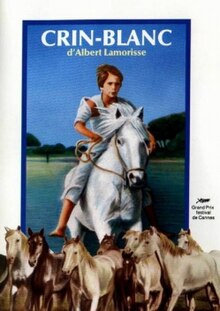White Mane
| White Mane | |
|---|---|

Promotional poster
|
|
| Directed by | Albert Lamorisse |
| Produced by | Albert Lamorisse |
| Written by |
Screenplay: Albert Lamorisse Commentary: James Agee Albert Lamorisse Saul J. Turell Story:: Denys Colomb de Daunant |
| Starring | Alain Emery |
| Narrated by |
Frank Silvera Les Marshak |
| Music by | Maurice Leroux |
| Cinematography | Edmond Séchan |
| Edited by | Georges Alépée |
| Distributed by | Films Montsouris Janus Films |
|
Release date
|
March 1953 |
|
Running time
|
47 minutes (France) 31 minutes (USA) |
| Country | France |
| Language | French |
White Mane (French: Crin-Blanc and Crin Blanc, Cheval Sauvage) is a 1953 short film directed by French filmmaker Albert Lamorisse.
The forty-seven-minute short, filmed on location in the marshes of Camargue, France, won numerous awards on its release, including the Short Film Palme d'Or Grand Prize at the Cannes Film Festival. The film also became popular with children and was marketed for them. The story tells a fable of how a young boy tames a wild white stallion called White Mane.
In the marshes of Camargue, France, a herd of wild horses roam free. Their leader is a handsome white-haired stallion named White Mane (Crin Blanc in French).
A group of ranchers capture the wild stallion and place him in a corral. Yet White Mane escapes. A boy named Folco (Alain Emery), who lives with his fisherman grandfather, watches intently as White Mane escapes, and he dreams of one day handling White Mane. The ranchers once again try to capture White Mane and fail. Folco asks the men if he can have the white horse. Yes, says one of the men, "but first you have to catch him, but your fish will grow wings before you can manage that."
Later Folco comes across White Mane in the marshes, and he tries to rope him. However, White Mane gallops and drags Folco in the water for quite a while. Folco refuses to let go of the rope and almost passes out. White Mane relents and the two become friends.
White Mane returns to his herd and another horse challenges him for dominance. White Mane loses the fight and returns to join the boy.
The ranchers return and try to spook White Mane by setting fire to the area he and his herd live in. Folco jumps on White Mane (for the first time) and rides him bareback across the marshes of Camargue, over the sparse dunes to the sea. The ranchers give chase and surround them, but they refuse to be caught. With Folco on his back, White Mane rides into the sea. The film ends as the narrator states that White Mane took Folco to an island where horses and children can be friends forever.
The story is based on real horses that are found in the Camargue region in southeast France. For centuries, possibly thousands of years, these small horses have lived wild in the harsh environment of the wetlands of the Rhône delta, the Camargue marshes, developing the stamina, hardiness and agility for which they are known today. They are the traditional mount of the gardians – Camargue "cowboys."
...
Wikipedia
